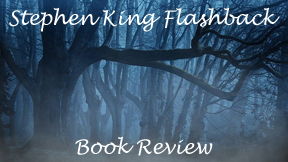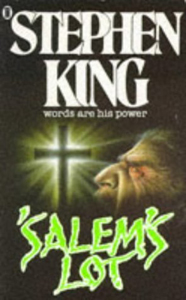“Carrie” (1974) was a remarkable debut novel, but Stephen King’s sophomore effort “’Salem’s Lot” (1975) is even better. Here we see a confident, almost fully formed writer. King resurrects the template of vampire novels, but he truly writes about people of all walks of life in the crumbling Jerusalem’s Lot in southern Maine.
I didn’t even realize the book was about vampires until a quarter of the way in, and it’s not until the halfway point that King uses the word “vampire.” King effectively sets up a slow-burn creepy mood as semi-successful novelist Ben temporarily moves back to his childhood town for inspiration.
A place in vampire lore
In the prose, King openly acknowledges a debt to Shirley Jackson’s “The Haunting of Hill House” when writing about the Marsten House, which overlooks the town from atop a bluff, its shuttered windows resembling eyes. Later, the author references Bram Stoker and old pulp comics.

“’Salem’s Lot” (1975)
Author: Stephen King
Genres: Vampire fiction, Americana
Setting: Jerusalem’s Lot, Maine, 1975
I wonder if King was somewhat resurrecting vampire fiction. Vampires have never not been popular since the start of the 20th century (Stoker’s “Dracula” came out in 1897), but at the time of “’Salem’s Lot” the touchstone stories came via TV (“Dark Shadows”), film (“The Omega Man”) and comics (“Blade”). King’s book predates Anne Rice’s career by one year.
There was already flexibility in the genre, and King chooses to lean into the dark shadows, with no humor. Fitting with the novel’s psychological brand of horror, vampire Barlow’s success isn’t due to strength or speed or thick skin, but his ability to lock eyes with a victim and hold them under his sway. Someone bad at making eye contact would have the best defense against Barlow.
A real world approach
By picking and choosing among the rules, King creates verisimilitude. The turning process is gradual. A vampire drains a victim over the course of days; during this period they are “almost-Undead.” A powerful vampire can enter people’s homes, but the almost-Undead have to be invited.
King includes the sensual aspects of vampires but in a perverse way. Victims have erections even as they are repulsed by the stench of the bloodsucker as it approaches their throat.
The slyness about whether this is a straight vampire novel creates uneasiness. A person could merely have the flu, but then again they might be in the process of turning. When someone sees something clearly, King still leans into the psychology; they are haunted by the image and know they’ll forever be haunted.
Kids’ and adults’ fears
As we saw in “Carrie,” King maintains a connection to his younger years better than the average person. Several people join Ben as main characters, and one of them is Mark, whom we meet when he beats up his school bully – logically understanding that violence is the only means of communication.

King emphasizes the notion of vampires encroaching on the real world. Mark immediately believes in vampires because he sees one: That’s all the evidence a child needs. Veteran school teacher Matt believes once he reads up on the subject; King openly dubs him the group’s Van Helsing. But in contrast to Mark, merely seeing a vamp gets him laid up at the hospital.
From Chapter 10:
The night before, Matt Burke had faced such a dark thing and had been stricken by a heart seizure brought on by fright; tonight Mark Petrie had faced one, and ten minutes later lay in the lap of sleep, the plastic cross still grasped loosely in his right hand like a child’s rattle. Such is the difference between men and boys.
King mulls our loss of credulity with age, seeing it as a bad thing. Ben’s girlfriend Susan is caught up on the word “can’t.” She can’t believe in vampires, despite the evidence. King asks people to look at evidence without using the word “can’t.” It leads to a world full of possibilities.
King obsesses over people’s belief and nonbelief. But although this is a long novel – 451 pages – he doesn’t overwrite parts you’d fear he’d overwrite. A remarkable amount of the violence happens off page – including offing of major characters – but we feel the impact on the survivors.
Wider commentary
The grounding in a recognizable town makes “’Salem’s Lot” a classic. About 3,000 people live there. He gives us a robust cross section via bird’s-eye-view passages where he tells us what people are doing at various moments. There are about three dozen developed characters, and every time he comes back to one, I remember who they are.
The author has sympathy for the townspeople, but there are a few nasty ones, including a terrifying guy who comes home to find his wife and her young lover. He drives off the lover before beating his wife. This sets up a nice revenge scene later for the lover. Even here, King pulls back and lets things play out off-page.
This approach is effective because he’s commenting on something bigger. King isn’t impressed with some trends in America. A Korean War veteran notes with disgust that young people loved the bloody Western that was the final showing at the local drive-in. Society is becoming crass. In fact, one person argues the town is already dead. That’s why Barlow moved in.
Death of the small town
But social commentary is a small part. “’Salem’s Lot” impresses me as a portrait of a town’s declining days – for whatever reason(s) it declined. King conveys the sadness of this, but also the beauty, via passages about day turning into night and the changing of the seasons.
From Chapter Six:
But when fall comes, kicking summer out on its treacherous ass as it always does one day sometime in September, it stays awhile like an old friend that you have missed. It settles in the way an old friend will settle into your favorite chair and take out his pipe and light it and then fill the afternoon with stories of places he has been and things he has done since last he saw you.
At its heart, “’Salem’s Lot” isn’t about vampires, and it’s not really about any of the focal characters. They are well drawn, and I like them, but they won’t stick with me like the overall novel will. It’s about the cycle of life in all its wonder and horror.
On Fridays, RFMC reviews a Stephen King book, adaptation or related work. Click here to visit our Stephen King Zone.

